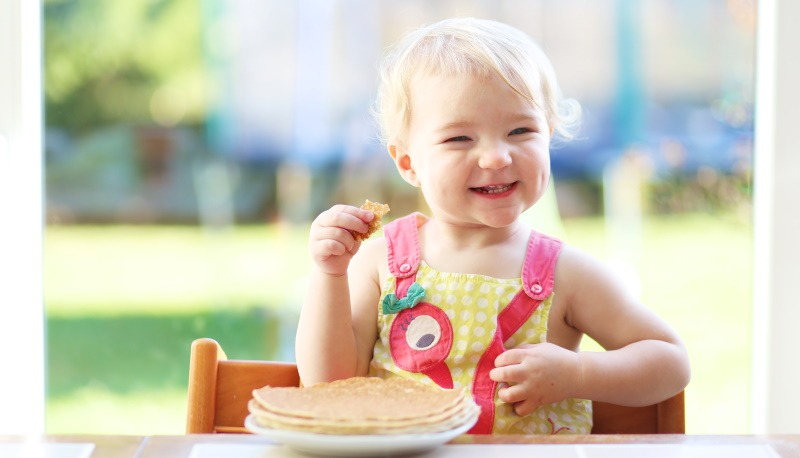This article will give you the best iron-rich foods for kids, why they need iron, how much iron babies and children need, yummy iron-rich recipes, and smart tips for optimal iron intake.

Already from around 6 months of age, babies need foods that contain iron. Baby formula is usually iron-fortified, while breastmilk contains very little iron.
In any case, once your child has started to eat solid foods, it is good to make sure that some of the foods are high in iron.
A Guide to Iron-Rich Foods for Kids & Why They Need It
In this article…
Why Do Children Need Iron?
Iron is important to avoid iron deficiency – mild or severe anemia. This is because iron helps the body to produce red blood cells – which in turn are needed for the blood to transport oxygen from the lungs to the rest of the body.
Iron is also important for brain development – insufficient iron intake has been found to be connected to behavioral issues later on in life.
On the other hand, too much iron can lead to nausea, diarrhea, and tummy pain. A very high intake can even be poisonous.
“Very high”, would, however, mean giving your child iron supplements, which is something you should never do without a recommendation from a pediatrician. Also, make sure your curious toddler or child can’t reach and open your own supplement bottles if you have any!
At What Age Do Children Need Iron-Rich Foods?
The thing is; children need iron-rich foods throughout their whole childhood, from 6 months of age and up.
Babies do need iron already from birth, but the little iron that is in the breastmilk is enough during their first months of living. Formula-fed babies also get enough iron as long as the formula is iron-fortified. (Do check that, to be sure!)
Why 6 months is a breaking point is because at around this age, a breastfed baby will have used up the iron stored in the baby’s body while still in the womb.
How Much Iron Does My Child Need?
The recommended iron intake varies slightly in different countries. While this can be confusing, it can also be comforting – the exact amount is not very important! The following are the recommendations by age in the US (SOURCE):
| Age group | The recommended amount of iron a day |
|---|---|
| 7 – 12 months | 11 mg |
| 1 – 3 years | 7 mg |
| 4 – 8 years | 10 mg |
| 9 – 13 years | 8 mg |
| 14 – 18 years, girls | 15 mg |
| 14 – 18 years, boys | 11 mg |
Symptoms of Iron Deficiency in Children

Most symptoms of iron deficiency will not show until the child really has a deficiency. There are no real “early warnings”.
Some of the symptoms are that the child is very tired, pale, get ill often, has cold hands and feet, rapid breathing, and behavior problems. An interesting symptom is something called pica, which involves unusual cravings for substances like paint and dirt.
Children at risk for iron deficiency are e.g:
- Premature babies or those with a low birth weight
- Babies who drink cow’s milk or goat’s milk before the age of 1-year-old
- Breastfed babies who aren’t given complementary foods containing iron after age 6 months
- Babies who drink formula that isn’t fortified with iron
- Children ages 1 to 5 who drink substantial amounts (24 ounces/7 dl) of cow’s milk, goat’s milk or soy milk a day
- Children who have been exposed to lead
- Children who don’t eat enough iron-rich foods
- Children who are overweight or obese
So, as you can see, iron deficiency is to a large extent avoidable, by serving the right kind of foods to your child.
If you are worried, make sure to consult a doctor. Iron deficiency can easily be detected in a blood test.
How to Make Sure Your Child Gets Enough Iron
Further down in this article, you’ll find a list of iron-rich foods for kids. You’ll also find a number of iron-rich baby food recipes.
However, there are a few important things to know about how iron is absorbed and how you can make sure that your child can actually make use of the iron in the foods you serve.
Depending on what you serve together with the iron-rich foods, your child’s body may take up between 5 and 40% of the iron in the foods! Huge difference!
Iron in Meat is the Easiest for the Body to Absorb
While many vegetables, fruits, and berries are excellent sources of iron, meat is the best because the human body absorbs that iron the most easily. (2-3 times better than vegetable iron sources)
In addition, when you add meat to a meal, the body actually also takes up more of iron from other foods sources in that meal. So, if you, for example, serve chicken and broccoli together, the total iron intake will be higher than if you served these to foods on separate occasions.
C-vitamin is an Iron Booster
Another trick is to serve iron-rich foods to kids together with c vitamin-rich foods. The c-vitamin makes it easier for the body to absorb iron in vegetables.
You can read more about the benefits of c-vitamin here and in which foods to find it.
Use an Iron Pan for Cooking
This is a pretty cool tip for adding iron naturally to your family’s food. If you make the food, like for example a pasta sauce or casserole, in an iron pan, the iron content will be many times higher than if cooked in a regular pan. Just make sure you use one of those oldfashioned black pans and not one that’s enameled.
Be Careful with Cow’s Milk
Cow’s milk contains calcium, which can inhibit the iron absorption. In addition, cow’s milk contains very little iron.
The recommendation is to avoid cow’s milk (as well as goat milk ) to drink during a baby’s first year.
It can also be wise to offer water to drink with iron-rich meals rather than cow’s milk. Of course, serving some yogurt or a bit of milk with the porridge is fine.
List of Iron-Rich Foods for Kids
In this list of foods, the specified amount contains 1 mg of iron. (Check the table above for how much iron your child needs per day depending on age:)
- 3.5 oz (100 gram) chicken breast
- 3.6 oz (110 gram) salmon
- 1.4 oz (40 gram) beef
- 1.8 oz (50 gram) lamb
- 0.7 oz (20 gram) tofu
- 3.5 oz (100 gram) boiled egg
- 7 oz (200 gram) broccoli
- 5 oz (1.5 dl) green peas
- 1.7 oz (0.5 dl) lentils
- 2.5 oz (0.75 dl) green beans or chickpeas
- 7 oz (200 gram) brown rice
- 2.6 lb (1.2 kg) (!) boiled white rice (just showing this to compare!)
- 2.5 dried apricots
- 8 prunes
- 1.7 oz (0.5 dl) oatmeal
- 3/4 tablespoon chia seeds
- 1 oz (30 gram) iron-fortified rice cereal
These are examples of iron-rich foods for kids, that you can use to plan the baby and toddler food that you cook. Remember, that is not enough to just add together these foods until you reach the amount of iron recommended for your child’s age. The human body cannot absorb all the iron in the foods, as explained above.
Make sure to combine iron-rich foods with C-vitamin rich foods, and to avoid serving cow’s milk to drink with the meal.
Iron-Rich Baby Food Recipes (for Toddlers and Older Kids too)

Here are some recipes with iron-rich foods for kids. Most of them can be used for babies as well as older children. (If not, it is clearly stated!) Depending on your child’s age and how used he or she is to eating solid foods, you can vary the texture from smooth and runny to just regular bites.
Remember to always go slowing when introducing new foods to babies, and make sure you know what foods to avoid for babies younger than 1 year old.
Oatmeal Porridge with Cinnamon and Apple
- 1.7 oz (0.5 dl) oatmeal
- 0.5 teaspoon cinnamon
- 3-3.4 oz (0.75-1 dl) of cow’s milk, oat milk, or other milk (but not rice milk)
- 0.5 tablespoon unsalted butter
- 0.5 grated apple
Instructions:
- Mix together oatmeal, cinnamon, and milk.
- Heat slowly in the micro oven or on the stove. Stir constantly if heating in a pan. It will only take a couple of minutes. Add the butter and let it melt.
- Let the porridge cool a little bit and then add the grated apple. Serve!
Iron-Rich Swedish Pancakes
Swedish pancakes are flat – i.e. no baking powder. They are easy to make and easy to eat. And yummy if you ask most babies and toddlers. :-)
In this recipe, the number of eggs is doubled, and to reduce the gluten content, the amount of wheat flour is reduced.
Ingredients:
- 5 eggs
- 5 oz (1.5 dl) wheat flour or sorghum flour
- 3.4 oz (1 dl) oat flour or buckwheat flour
- 0.75 teaspoon salt (exclude if cooking for a baby)
- 1.7 cups (4 dl) milk – cow’s milk (not to babies), oat milk, breastmilk, formula or a combination of these
- 1.7 oz (50 gram) unsalted butter
Instructions:
- Whisk eggs and flour to a smooth batter. Add milk and salt (optional, see above). Melt the butter and add it to the batter. Let the batter rest for 15 minutes.
- Fry the pancakes in oil or butter in a frying pan on both sides until they have a nice golden color.
- Serve with, for example, apricot pure (above), blueberries, or just as they are. Cut in small pieces for babies and toddlers.
- Store in the fridge for a few days. You can freeze leftovers.
Omelet with a Twist
Omelet is great iron-rich food, which can be varied endlessly. Just add whenever leftovers you have, and you have a new dish! Omelette is great for breakfast, lunch, picnic, or just a snack.
Here is a more filling version than just eggs and some ideas on variations. And since the recipe is made with 3 eggs, you can share the meal with your child, it is definitely enough for more than one person!
Ingredients:
- 1 or 2 potatoes, depending on size. Boiled or raw
- 3 eggs
- 2 tablespoons of milk or cream
- 0.5 small onion
- salt and pepper to taste – exclude the salt completely for babies younger than 1-year-old.
- butter or olive oil for frying
- Variation: for example pieces of leftover sausage, minced meat, beans, broccoli, cheese
Instructions:
- Cut the potatoes in slices or small dices. Fry it slowly – particularly raw potato will take a bit of time, like 5-7 minutes at least. Boiled potato just needs to get a bit of surface and color.
- Add the finely chopped onion, and fry slowly on low heat until transparent and soft. Do not burn it!
- Add the extra ingredients you want and fry for a few more minutes.
- Crack the eggs in a bowl and blend with the milk or cream and possibly some salt and pepper (depending on the age of your child).
- Pour the eggs over the mixture in the pan and lower the heat. Cook for a little while until the omelet is ready. You can put on a lid to make it go faster but check often so you don’t burn the omelet.
- Let it cool and serve. Cut in small pieces for babies and toddlers to feed themselves.
This is not for introducing baby food since purees are preferred for a start, but can be served once the baby is old enough for finger foods (usually at around 8 months), and you have already introduced egg to your baby (can be done from 6 months).
Apricot Puree
Apricot puree is great to spice up porridge, rice-cereal, or basically any food if you want to increase the iron content of a meal.
Ingredients:
- A bag of dried (organic) apricots)
- Water
Instructions:
- Place the apricots in a bowl and cover with cold water. Keep like this for at least 2 hours.
- Drain the water, but save it. Mix the apricots and add some of the apricot water slowly until you have your preferred texture.
- Freeze in 1-oz cubes.
- The puree can be added to for example porridge, yogurt, or eaten as it is as a dessert.
Fruit & Tofu Dessert
Tofu is very protein-rich. It is recommended for babies older than 8 months, just like meat and eggs. However, since tofu is made from soybeans it is an allergen – similar to cow’s milk protein, and many children are allergic to both if they are allergic to one of these, make sure to introduce tofu slowly the first time.
This purée can be varied with different fruits to be combined with the tofu and banana.
Ingredients:
- 1 mango or a similar amount of frozen mango cubes OR one pear
- 1 banana
- 1/3 container of silken tofu
- A bit of water or tofu to adjust the consistency
Instructions:
- Peel and slice the banana. Peel and chop the mango or pear (or other fruit).
- Place the fruit into a blender or food processor with the tofu and blend well.
- Increase the amount of tofu to thicken the consistency or add a bit of water to thin it.
- You can store the puree in the fridge for a few days in an airtight container or freeze it.
Salmon Balls with Spices
Ingredients:
- 0.22 pounds (100 gram) fresh salmon
- Some spices, such as chive, tarragon and a little bit of mustard, or dill and lemon, or lime and virgin coconut oil for an Asian touch.
- 1-2 teaspoon olive oil
- A little bit of salt (not for babies)
Instructions:
- Cut the salmon in pieces and mix with your choice of spices. Add the olive oil ( or coconut oil) and mix some more.
- For children older, you can add salt to the mixture.
- Put some of the salmon in a little tea ball and dip into boiling water for about 1 minute until it is ready. Mash and mix with oil or water to make it a puré for babies, or serve the salmon balls in pieces or as they are for older babies, toddlers and children.
- Serve with, for example, the broccoli or green pea purees below or with just boiled green peas and boiled potatoes or brown rice.
- If you make slightly bigger balls, you can form them with two spoons or your fingers, simply lower them carefully into the water and let them simmer for a few minutes.
Now you have a meal for everyone in the family!
Broccoli with Olives
This puree can be used for baby food introduction for young babies as well as simply yummy veggies for older kids as part of their meal.
Ingredients:
- 0.7 pounds (300 gram) fresh (organic) broccoli)
- 1.7 oz (1/2 dl) water from boiling/steaming the broccoli (or other water)
- 2 tablespoons olive oil
- 16 green olives
- 1 garlic clove
- 0.5 avocado (optional)
Instructions:
- Cut the broccoli in pieces and peel the woody broccoli stems carefully before cutting it in pieces.
- Boil or steam the pieces until soft
- Drain the water, but Save 1/2 dl of the water or add to a total of 0.5 dl of water if you steamed the broccoli. Add the olive oil, olives, and pressed garlic, and mix the broccoli pieces to a puree.
- When the puree is no longer hot, you can add avocado too, if you want the puree to be more filling.
- For even more seasoning, you can add a little bit of grated parmesan cheese.
- And for less seasoning, you can of course exclude the olives! :-)
Green Pea Puree with Lemon and Mint
Ingredients:
- 1.3 cups (3 dl) frozen green peas
- 2.5 tablespoons neutral, healthy oil, such as organic sunflower oil
- 2 tablespoon fresh lemon juice
- 8 fresh mint leaves
Instructions:
- Thaw and mix the green peas to a puree. You can press the puree through a small mesh strainer to get rid of the pea peel for young babies or picky eaters if needed.
- Add the lemon juice and finely chopped mint leaves. You can, of course, serve the pea puree without the seasoning too – it’s a great iron-rich food for kids.
- This puree is excellent for baby food introduction and as well as for older toddlers and children.
Beef with Garlic Seasoned Roasted Butternut Squash
Ingredients:
- 1 cup butternut squash, roasted
- 1/2 pound ground beef, preferably organic
- 2 tablespoon oil
- 0.5 garlic clove
- 1 teaspoon dulse flakes (algae)
- 2 sprigs fresh thyme
Instructions:
- Heat the oven to 400F (200 C).
- Cut the squash in half, brush with olive oil and season sprinkle a bit of pressed garlic on the halves. Place face down on a baking sheet. Leave seeds in, you can scoop them out later when squash has cooked. Roast it for 30-45 minutes depending on size. It should be tender when it is ready.
- While the squash cooks, place beef in a pan and sprinkle with dulse flakes and thyme. Brown until cooked through, but do not fry it hard. Place in a bowl with rendered fat and set aside.
- Now, take away the squash seeds. Cut the squash in small pieces or, to make a puree, place roasted squash, browned beef, and oil in a bowl and blend to preferred texture. You can mix with water, unsalted broth, breast milk, or formula.
- Babies and children that don’t need their food to be pureed can have a plate with squash pieces, meat, and for example, brown rice to feed themselves.
- Freeze the leftovers
That was it! If you got this far, I think you know everything you need to know about iron-rich foods for kids!
You know how much iron your child needs, why it is important, how to make sure you serve iron-rich foods, and what to look for to spot iron deficiency!
Any thoughts, questions, reflections? Or maybe you have additional tips or recipes to share with fellow moms?
Add a comment below, I’d love to “talk” to you! :-)
Read Next
- Feeding your toddler – lots of tips!
- Feeding your baby solids
- What Should My Toddler Eat? Nutritional Needs and Guidelines
- Baby & toddler vitamin guide
- More recipes!

Paula Dennholt founded Easy Baby Life in 2006 and has been a passionate parenting and pregnancy writer since then. Her parenting approach and writing are based on studies in cognitive-behavioral models and therapy for children and her experience as a mother and stepmother. Life as a parent has convinced her of how crucial it is to put relationships before rules. She strongly believes in positive parenting and a science-based approach.
Paula cooperates with a team of pediatricians who assist in reviewing and writing articles.



